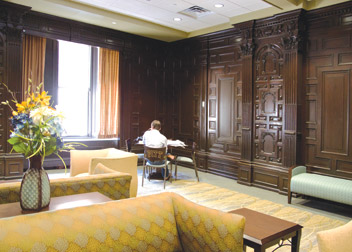Preserving the Old, Artfully Creating the New: Renovations Transform Former Concordia Club Into O’Hara Student Center
 First-floor study area showcases the oak paneling from the former Fort Pitt Hotel.
First-floor study area showcases the oak paneling from the former Fort Pitt Hotel. Pitt students will have a new place to meet, study, and relax this academic year—in the former Concordia Club, built in 1913 and recently transformed into the O’Hara Student Center, 4024 O’Hara St.
The stately building has approximately 35,000 square feet of space and was purchased by Pitt two years ago. The renovations, which included tearing out walls, updating the heating and cooling systems, replacing the roof, and upgrading the lighting, were completed in April of this year. The result is a compatible blend of the old and new. The charm of the social club’s Romanesque Revival architecture is still present, but the heavy salmon-colored drapes have been replaced with crisp white panels. What once were small dimly lit social rooms are now bright and spacious areas for group study, club activities, or student programming.
“It was becoming more difficult for the William Pitt Union to handle all the requests from student organizations for event space,” explained Kenyon Bonner, associate dean of students and director of student life at Pitt. Bonner says not only has the number of Pitt student organizations mushroomed over the years, but the groups have become more active on campus. At the same time, the groups’ storage needs have grown—an issue that the new center will resolve nicely with basement storage areas.
The O’Hara Student Center provides two ample venues—a first-floor dining room that can double as a large meeting room and a second-floor ballroom with an open balcony, large arched windows, and a small stage. The ballroom, which can hold approximately 450 people, is equipped with a state-of-the-art sound system. Bonner says freshman orientation programming is being held in the newly refurbished center, as will lectures, presentations, and fairs. The building is also the new home of Pitt’s Math Assistance Center and The Writing Center.
The Concordia Club, founded by members of the city’s German Jewish community and originally located on the North Side, was for many years a place where prominent Jewish citizens of Pittsburgh gathered. At its peak, the club had close to 300 members. Membership declined in later years, when Jewish individuals were no longer barred from other clubs because of their religion. But in its heyday, the club hosted many parties, weddings, and balls, and its chefs produced memorable high-end cuisine.
Pitt architects were challenged with renovating the building without disturbing its original grandeur.
“We looked at what was there, and we tried not to intrude too much on it,” says University Architect Park Rankin. “But with modern-day lighting needs and mechanical system upgrades, we knew we had to get in there and change a few things around.”
Immediately upon entering the new center, visitors see the dark-stained oak paneling. It once covered the lower level and bar of the Fort Pitt Hotel, considered one of Pittsburgh’s most elegant hotels when it was constructed at Penn Avenue and Tenth Street, Downtown, in 1905. When the hotel was demolished in 1967, Concordia Club members purchased the paneling and reinstalled it in their building.
Rankin’s team of architects beautified the ballroom by applying gold leaf trim to the large wall panels. A formerly blocked-off stairway is now revealed, providing access to a balcony where music ensembles once played for weddings and bar mitzvahs. The ballroom’s large ornate crystal chandelier, as well as two smaller ones, and a number of wall sconces all stem from an earlier renovation. Rankin says his team was able to track down the Strip District lighting fabricator who had made them more than 50 years ago.
“He came back, removed the chandeliers, and refurbished them,” Rankin explains. “The light bulbs were replaced with an LED light source, so they are energy efficient and much brighter.”
Throughout the building are spacious areas with comfortable chairs for students who want to study or socialize. This is a growing trend he noticed when he visited other universities—pleasant spaces for students to congregate, Rankin says: “They want a place to study other than in their residence halls.”
Bonner states that a restored building from the early 1900s adds character to campus: “It shows that we preserve and respect the architecture of Pittsburgh. And it’s something for which the students gain an appreciation.”
An official grand opening for the center is planned for early in the Fall Term.
Other Stories From This Issue
On the Freedom Road

Follow a group of Pitt students on the Returning to the Roots of Civil Rights bus tour, a nine-day, 2,300-mile journey crisscrossing five states.
Day 1: The Awakening
Day 2: Deep Impressions
Day 3: Music, Montgomery, and More
Day 4: Looking Back, Looking Forward
Day 5: Learning to Remember
Day 6: The Mountaintop
Day 7: Slavery and Beyond
Day 8: Lessons to Bring Home
Day 9: Final Lessons

